When and how to plant radish in open ground: rules for growing and care
Since the 12th century, for Russia, radish, along with turnips and horseradish, is one of the most popular crops that is present on the table every day. This attachment to radish is understandable: it is loved not only as food, but also as a powerful medicine, thanks to the presence of mineral salts, vitamins and trace elements. And now a juicy and tasty vegetable can be bought without any problems in any supermarket.
However, it is much more interesting and not difficult to grow it yourself in the country. To make sure you can do this, check out our tips and tricks for proper planting and proper care of your outdoor radish.
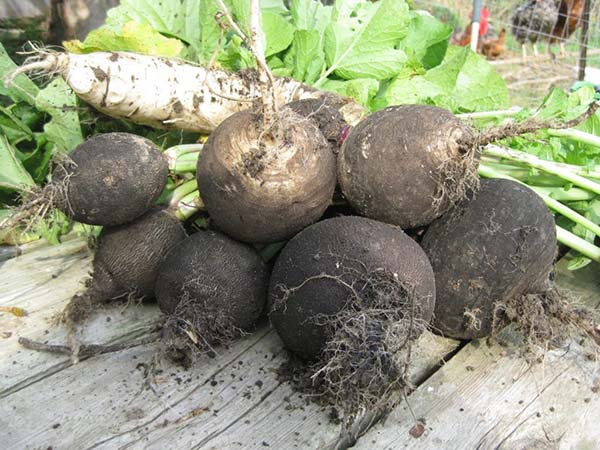
Content
Growing radish (white, pink, green, black): sowing rules, tips for care
In general, the rules for growing any radish are very similar, there are no fundamental differences in planting and caring for black, white or green (Margelan), except perhaps, except for the timing of their sowing, taste and useful properties.
Types and varieties
- White, popular varieties: early (Delicacy, Odessa 5, Maiskaya, Sudarushka), medium (Elephant fang, Dragon), late (Winter round white, Autumn giant);
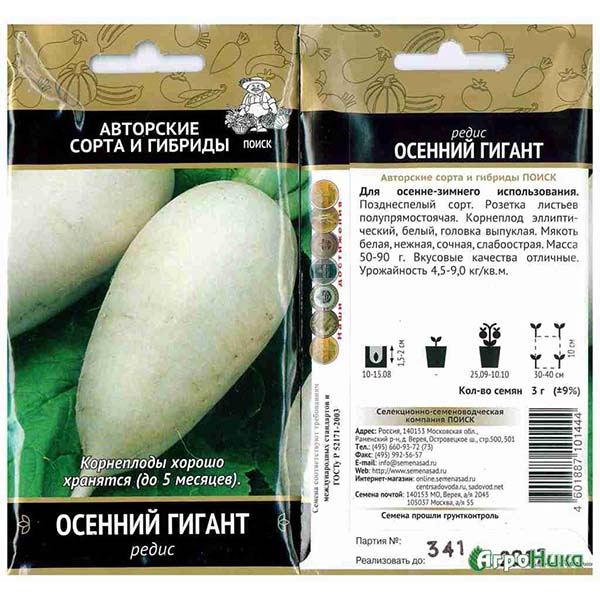
- Pink, popular variety: Raspberry moon (early maturing).
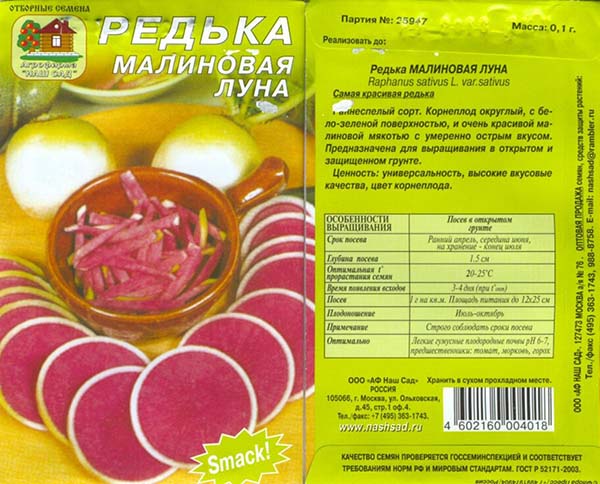
- Green (Chinese), popular varieties: Margelanskaya (mid-season), Green Goddess (early-season), Yuzhanka;
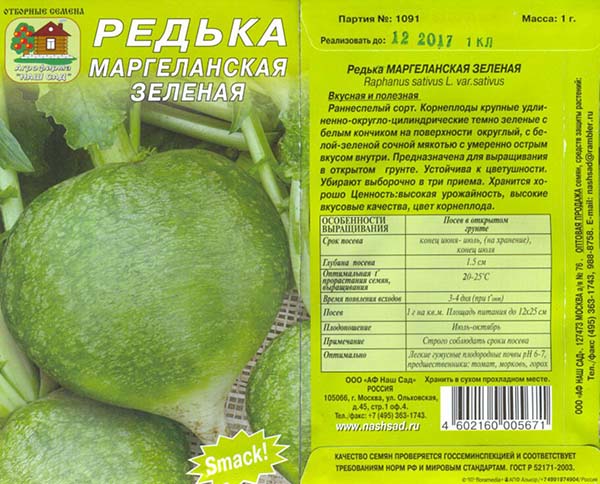
- Black, popular varieties: Winter round black, Black winter, Chernavka, Healer.
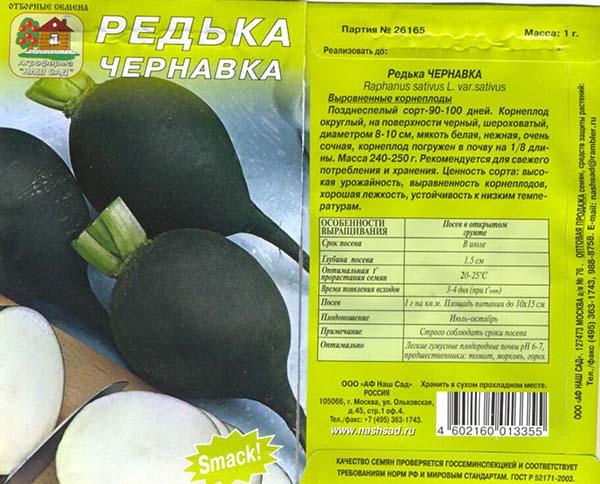
Planting dates: according to the lunar calendar, depending on the variety and region
The timing of sowing radish in open ground is largely determined by the vegetable variety:
- early small-fruited varieties can be sown already in March-April (if, of course, the weather allows. days;
- early ripening (summer) - in late April - early May, ripening period - 50-65 days;
- late (or they are also called autumn or winter, black) - in early or mid-July, ripening period - about 90 days.
However, it is equally important to take into account both the climatic conditions of the region and the current weather conditions. The optimal temperature conditions for seed germination are + 20-25 degrees, but planting is also allowed at + 15-20.
According to the lunar calendar in 2021
If you want to choose a specific date for planting a root crop, then the Lunar calendar will always come to your aid.
So, the most favorable days for sowing radish for seedlings or in open ground according to the lunar calendar in 2021 are:
- in April - 5-7, 9-15, 17-22, 27-30;
- in May - 2-6, 9, 11, 12, 20-22, 29-31;
- in June - 7-9, 11-14;
- in July - 4, 6, 8-11, 13-16, 27-29.
If we turn to the lunar calendar, then it is worth knowing that it is even more important not to plant a radish on unfavorable dates (the days of the Full Moon and New moons, as well as the period when the Moon is in Aquarius, because it is a barren and dry sign -italicized), and this is in 2021:
- in April -5-6, 12, 27;
- in May -2-4, 11, 26, 30-31;
- in June -10, 24, 26-27;
- in July -10, 24-25 (24 is also the Full Moon).
Video: radish - varieties, sowing dates and care
Further, on the example of its black variety consider the basic rules for growing radish: sowing and care in the open field.
How to properly plant a radish in open ground
There are a lot of varieties of this useful root crop at the moment, but black radish, due to its useful and medicinal properties, is of particular value.
Useful properties of a root vegetable
Black radish is both delicious and healing vegetable. If you have sand in your kidneys or liver, then with the help of a radish you can significantly improve your condition. It also helps if you have a cold (such as a prolonged wet cough), high cholesterol, and it also improves performance and stress tolerance during busy work schedules.
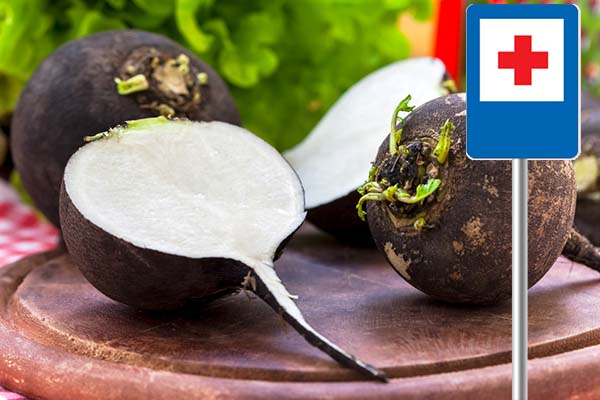
Note! You should not use radish (any) if you have peptic ulcer disease, inflammation of the gastrointestinal tract and liver, or if you have heart disease.
Another advantage of planting black radish is its suitability for long-term storage.
Sowing dates
The dates for planting black radish are in the middle of summer, namely, it is advisable to plant it from the 3rd decade of June to the 3rd decade of July.
If you plant it too early, then with a long daylight hours, it can go into flowers (it will begin to shoot and throw out flower-bearing shoots) and subsequently not give root crops. Therefore, in order to accurately wait for the ripening of the vegetable, observe the timing of its sowing.
Garden bed preparation: site selection and suitable soil
A good harvest of radish can only grow in the right spot. It is optimal to find a place that is illuminated by the sun most of the day.
As for the land, the radish grows best on fertile loamy soil, in other words, light humus soils with an acidity of 6-7 pH are suitable for it.
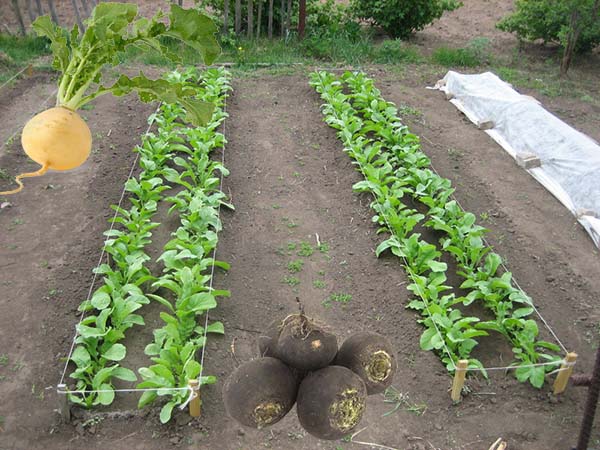
Preparing a garden bed for a radish is quite simple: you need to thoroughly dig up the ground (to a depth of 25-30 centimeters), add a couple of buckets of excellent compost, wood ash, and then mix everything again and level the bed.
Next, you need to make rows for sowing radish seeds. The sowing depth of seeds should be 1.5-2 centimeters. The distance between the rows should be maintained at 20-40 centimeters. The seeds themselves are optimally sown at a distance of 10-15 centimeters, but if you want to get an even higher yield, then sow them closer in order to subsequently thin out and get rid of weak plants, leaving only the healthiest ones.
Many summer residents practice joint sowing of radish with potatoes, cucumbers, onions, tomatoes and even corn.
As a rule, they try to plant a radish after harvest garlic... Also good predecessors there will be the following cultures: onion, tomato, cucumbers, carrot, beet and peas and other legumes.
Sowing seeds
Step-by-step instructions for sowing radish in open ground:
- Before sowing, it is advisable (but not necessary) to soak the seeds for 24 hours in a pink solution of potassium permanganate.
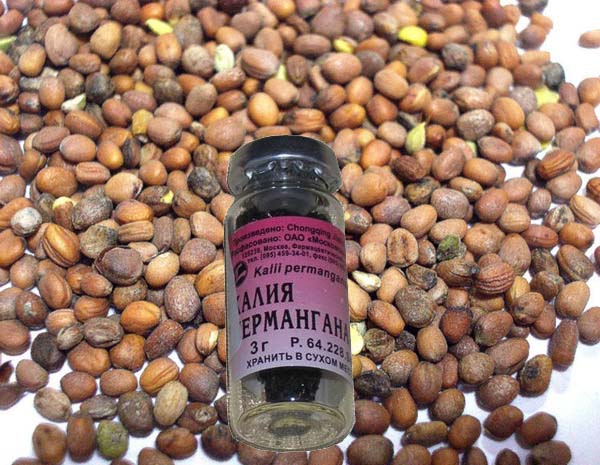
- Make grooves or planting holes with a depth of 1.5-2 centimeters every 5 centimeters (if you plan to thin out) or after 10-15 (if without thinning) at a distance of 20-30 centimeters.
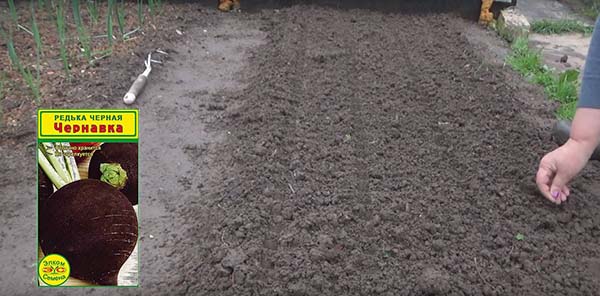
- Place seeds in grooves or holes, then cover with soil and compact slightly.
- Water abundantly (this can also be done after stage 2) and cover with foil (optional).
- Dust with ash and / or tobacco dust from cruciferous flea.
Video: sowing black radish
Outdoor radish care
Despite the fact that this vegetable is considered to be quite unpretentious, some care is required to obtain a rich and tasty radish harvest.
So, in first time after sowing desirable maintain high humidity in the gardenso that the seedlings appear together. As a rule, this takes about 3-5 days, but after germination for 1-2 weeks, the garden should be kept moist. There are two ways - either constant watering, or you can cover the bed with a film that will retain moisture.
A week later, through the emergence of seedlings, the bed follows first time thin outleaving only the strongest seedlings.
Further care of the radish is quite standard: on time to water (if you forget about watering, then the roots will grow small and bitter and will not be suitable for food), preventing the soil from drying out, at least once a week, loosen and weed.
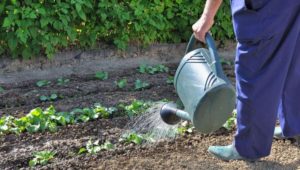
By the way! To reduce the number of watering, loosening, and weeding, you can mulch the beds with peat or humus.
Also, during the summer, you need to make sure that the seedlings do not hinder each other's development. If you notice that the plantings are thickened, then you should perform one more thinning, otherwise the roots simply will not be able to ripen normally and will turn out to be small.
As for the dressing of the radish, during the season it should be fertilized at least 2 times. The first time when 3-4 leaves appear (nitrogen feeding), the second time - a month after the first, when the root crop begins to grow actively.
It is advisable to use herbal infusions (organic matter) as a fertilizer. If you really need to make nitrogen feeding, then for feeding you will need ammonium nitrate (1 tablespoon for 10 liters of water).
Advice! It is very good to combine top dressing with watering.
Diseases and pests
Cruciferous fleas they are very fond of young shoots of radish, therefore, as measures to combat these pests, crops should be treated, more precisely, powdered with tobacco dust or wood ash.
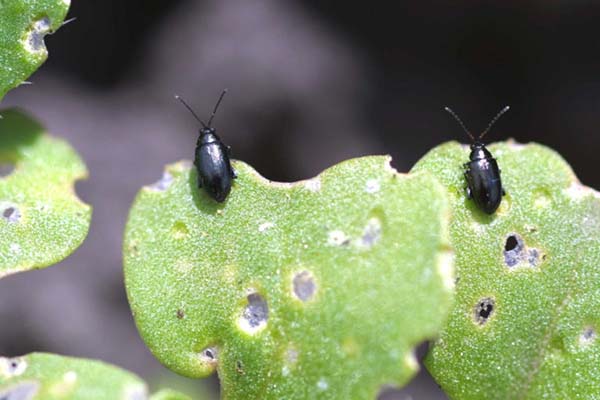
Harvesting radish for storage
If you want to store black radish for a long time, then you need to harvest and prepare it for storage according to certain rules.So, it must be collected on time in most cases before the end of October and always before the onset of frost. You need to pull out the vegetable, slightly digging in with a shovel. Next, you should get rid of the tops, but if you are determined to store the radish for a long time (for example, all winter), then you should leave 1-2 centimeters of the tops.
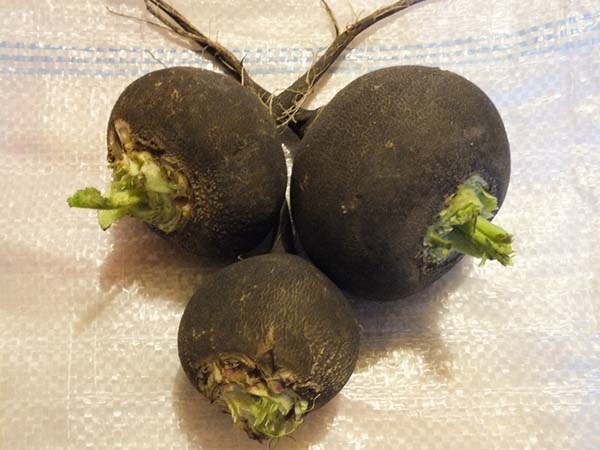
Important! If you put this root crop for long winter storage, then you cannot wash it, just shake it off of the dirt and that's it, otherwise it will rot.
Optimally put dry root vegetables in boxes with wet sand and remove to the basement or cellar for long-term storage.
You can also store the radish in refrigerator. In this case, the tops must be cut off completely, rinsed thoroughly, and then also shortened the tail, leaving 4-5 centimeters. Next, the roots should be processed in a slightly green solution of brilliant green, immersed in it for 1-2 minutes. When the vegetables are dry, they must be put in bags and put in the refrigerator.
By the way! The site already has an article about when to dig up and how to store the radish.
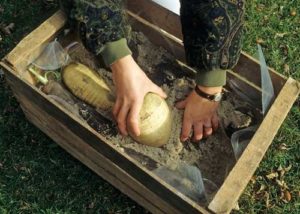
Thus, even a novice gardener can grow a radish (no matter what kind, white, Margelan or black). You just need to choose the optimal timing, properly prepare the soil and sow the seeds, and then continue to provide high-quality care for the root crop until it is fully ripe.
Video: black radish - from sowing to harvest

